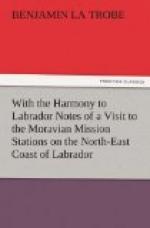Our voyage from Zoar to Nain occupied just twelve hours. We left about 5.30 A.M., and our anchor went down again before 5.30 P.M. The day was fine and warm, and the scenery changed continually. Often the way seemed barred before us, but, as we sailed on, a narrow strait opened to right or left, and as we neared Nain our voyage between the islands became more and more interesting. Presently some Nain Eskimoes caught sight of the “Harmony,” and posted off to the station in their sailing boat, which kept ahead the whole way. Two men came to meet us in their kayaks, and paddled alongside for some time, their light skin boats skimming over the water as easily as the flock of ducks which had just crossed our bows. Passing the island Taktuk, a salute fired by the one Eskimo visible was followed by such a concert of howls from his dogs seated in a row on a rock as made us all laugh. Next the Kauk came in view, a great rock looking like a skull, or, as its name implies, “a forehead,” a very recognizable landmark often anxiously looked for on sledge journeys. Paul’s Island, with its deep inlets, was to our right, and now a good wind sent us forward past headland after headland till Nain came out from behind the Suederhucke. First we could see the Eskimo village, whose inhabitants were, as usual, firing their guns and shouting; then the church came in sight, and the mission-house with flag at the mast head; then the store and the little pier, which, as we approached, was crowded with Eskimoes singing, “Now let us praise the Lord.”
THE FIRST EVENING AT NAIN.
[Illustration]
Nain was the third station visited on our voyage northward along the bleak but grand coast of Labrador. Hopedale and Zoar had already been left behind in the south; Okak, Hebron, and Ramah, all to the north of Nain, had yet to be touched at in their turn. Each successive station has its own distinctive features and so presents fresh interest to the visitor. Nain, the oldest of all, is rich in associations with the past as well as very interesting in the life, spiritual and temporal, of the mission-house and the Eskimo dwellings, which constitute this little Christian village of three hundred inhabitants.
August 19th.—I take up the story on the Sunday evening, when, about a quarter past five o’clock, the “Harmony” came to her anchorage some three to four hundred yards from the mission premises on the north shore of the Nain bay. It is a mercy when no accident occurs on the arrival of a ship at a station, for the Eskimoes are rather wild in their expression of their joy, and rather careless in handling powder. Just a year ago they burst a little cannon in welcoming the “Gleaner.” The pieces flew in all directions about the heads of those standing round. Yet by God’s great goodness not one was hurt. One man’s cap was knocked off by a flying fragment of iron.




